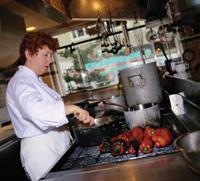McGee on food and cooking: an encyclopedia of kitchen science, history and culture
McGee on food and cooking: an encyclopedia of kitchen science, history and culture
Harold McGee
London, UK: Hodder & Stoughton | 2005 | 884pp | ?30.00 (HB) | ISBN 0340831499
Reviewed by David Chamberlin
This book is an extensively revised and updated edition of the author’s classic book On food and cooking: the science and lore of the kitchen which was first published in 1984 and won the 1986 Andre Simon award for food book of the year. It inspired millions, from serious professionsals to interested amateurs, in their understanding of the food we eat and the cooking processes that turn the ingredients into the myriad dishes that we
enjoy.

Heston Blumenthal, chef-proprietor of the Fat Duck restaurant at Bray in Berkshire, UK, recently dubbed ’the best restaurant in the world’, claims to have been inspired to experiment in cooking by McGee’s original book (Chemistry World, May 2005, p34).
This new edition, like the original, is not a recipe book, but rather demands that you apply the information gleaned to your own cooking. It is also not an in-depth scientific text needing a degree in chemistry to understand. If you are looking for a text on the chemistry of the components in our food Tom Coultate’s Food: the chemistry of its components would be much better. And if you want an in-depth scientific study of the physical and organic chemistry of cooking processes then look no further than Peter Barham’s The Science of Cooking.
Enough of what this book is not - what is it? It gives a wealth of well-presented information on the history of food and drink, with and answers to those intriguing questions that you have often wondered about: What is the effect of heat on fish proteins and texture? What makes white meat white? Does searing seal in the flavour of meat? What is the difference between fondant and fudge? What are the characteristics of a good sauce?
It is a unique blend of science, explained in layman’s terms, together with history and literature, written by a man with degrees in both science and English literature. It also has a good further reading list and index.
McGee’s new book has increased from 684 pages to an even more massive 884 pages, but it is not intended to be read from cover to cover - rather it is to be dipped into and savoured in tasty morsels. This edition has more on newer food ingredients such as grass-fed beef, farmed salmon, balsamic vinegar and extra-virgin olive oil. It also has a new emphasis on food flavours.
One criticism about this otherwise excellent book is that it retains its dowdy 1980s look. Perhaps this retro style is intentional, but I feel that a book on food and cooking these days should be lavishly illustrated in colour, instead of black-and-white line drawings and grey tint boxes. The publishers have missed an opportunity to attract the present day general readership for whom presentation is everything.
Nevertheless this encyclopedic treasure trove is an excellent buy for anyone interested in food and cooking. I am sure it will find its way into family kitchens as well as
chefs’ libraries and be constantly dipped into for information and inspiration.












No comments yet